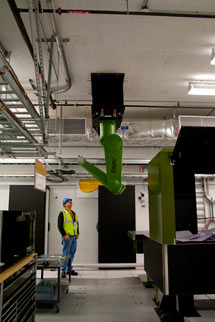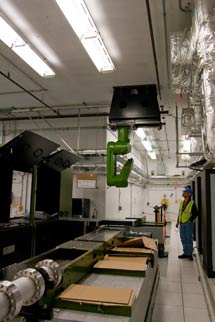
Handy Links
SLAC News Center
SLAC Today
- Subscribe
- Archives: Feb 2006-May 20, 2011
- Archives: May 23, 2011 and later
- Submit Feedback or Story Ideas
- About SLAC Today
SLAC News
Lab News
- Interactions
- Lightsources.org
- ILC NewsLine
- Int'l Science Grid This Week
- Fermilab Today
- Berkeley Lab News
- @brookhaven TODAY
- DOE Pulse
- CERN Courier
- DESY inForm
- US / LHC
SLAC Links
- Emergency
- Safety
- Policy Repository
- Site Entry Form

- Site Maps
- M & O Review
- Computing Status & Calendar
- SLAC Colloquium
- SLACspeak
- SLACspace
- SLAC Logo
- Café Menu
- Flea Market
- Web E-mail
- Marguerite Shuttle
- Discount Commuter Passes
-
Award Reporting Form
- SPIRES
- SciDoc
- Activity Groups
- Library
Stanford
Around the Bay
XPP's Monster Arm
Last week the X-ray Pump Probe instrument, slated to become the third instrument at the Linac Coherent Light Source, reached a milestone in its installation phase with the addition of a robot arm. Dubbed "Monster" by XPP Instrument Scientist David Fritz for its large size and green hue, the robot was hoisted to the ceiling last Wednesday after more than a year of planning and preparation. This marks the first time a robot arm like Monster has been installed for the use in experimental physics.
"This has not been done before in physics," said XPP Engineer J. Langton who along with Jim DeLor and Jim Defever did much of the planning for the installation. "These scientists want a lot of flexibility, and with this robot arm, we can give it to them," he said.
Robots like Monster are typically mounted on the floor for manufacturing cars, not flipped upside-down and hung from the ceiling for physics research. Because Monster is upside-down, a few adjustments had to be made to the robot. An engineer from the manufacturer, Stäubli, came to assist in the installation process, opening up the arm to change the robot to a ceiling mount configuration before it was raised off the ground.
The robot has a 2.1 meter, or nearly 7 foot, reach and weighs more than 500 pounds. Monster is attached to a 5 foot tall "robot support" on the ceiling, making the final height of the outstretched arm more than 10 feet. The arm will hold a camera that scientists can maneuver in a spherical pattern to snap pictures of their samples from any angle.
"What we're asking the robot to do is simple in comparison to what it can do," Langton said. "These robots are extremely precise. We can move this little camera to position it within less the width of a strand of human hair."
Monster will allow physicists to image atomic reactions in a pump-probe experiment from all sides. "After hitting the molecules with a laser, the LCLS pulses will expose the molecules," Langton explained. "Physicists can change the time between the first laser and LCLS as well as the camera angle. Put it all together and they can basically make movies of the molecules' reactions. That is why the precision is so important."
With the robot arm in place, nearly all of the planned large objects are now installed in the XPP Hutch, including massive granite blocks. These plates will not vibrate and respond very slowly to heating or cooling. "It will take 30 days for the blocks to expand if the temperature rises two degrees in the experimental hall," Fritz said. This kind of stability is key when physicists are studying ultra-small and ultrafast nanoparticle activity. In the New Year, X-ray diagnostics and optics will be assembled on top of these imperturbable blocks before the first commissioning shift begins in May.
—Lauren Knoche
SLAC Today, December 14, 2009

